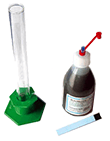Measuring acidity
This is made by titration by means of a sodium hydroxide (NaOH) solution until neutralization of the solution. The neutral point can be defined either by colour transition of a coloured indicator, generally the bromothymol blue, or by means of a pHmeter [ Device allowing the pH measurement of a solution by dipping in it an electrode. Small pHmeters can be found moderately priced and accurate enough. ] (more convenient for coloured juices). The acidometer [ An acidometer is a test-tube graduated directly in g/L equivalent tartaric acid, provided one use a special coloured NaOH solution whose concentration fits to the graduations of the test-tube (very practical system). ] can also be used.

Most generally, a known measured volume (often 10 mL) of filtered juice is withdrawn into a Becker. This juice can beforehand be diluted (with a precisely known factor: 2 x, 4 x...) because it is very acidic or very coloured (the decolouration by means of activated charcoal would alter the measure (acidification) and is not appropriate.
5 drops of bromothymol blue solution [ Dissolve a knife tip of bromothymol blue in 25 mL alcohol 50%. ] is added. The juice, if clear, turns yellow.
By means of a 25 mL graduated burette, a NaOH solution of well-known concentration (generally 0.1 N i.e. 0.1 Eq/L) is added dropwise, well mixing after each drop. The addition is stopped when the juice colour turns and remains blue after a few seconds, or when the pHmeter indicates 7.0 (neutrality).
It is recommended to perform the measurement several (3) times in order to avoid errors.
Warning: the NaOH solution must be kept in a tightly sealed plastic bottle (NaOH is air sensitive and slowly reacts with glass).